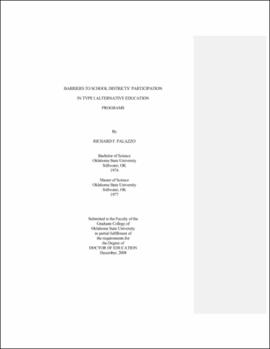| dc.contributor.author | Palazzo, Richard Frank | |
| dc.date.accessioned | 2013-11-26T08:34:48Z | |
| dc.date.available | 2013-11-26T08:34:48Z | |
| dc.date.issued | 2008-12 | |
| dc.identifier.uri | https://hdl.handle.net/11244/7531 | |
| dc.description.abstract | Scope and Method of Study: The purpose of this study was to explore the relationship among three barriers of change, and the selection, design and implementation decisions supporting Type I and non-Type I alternative education programs in Oklahoma school districts. Also examined were the relationship between superintendent and district demographics and the districts' choice of alternative education programs. Finally, the relationship between the three barriers of change and superintendent demographics was examined. This study was concerned with change theory, but more specifically the study examined three specific barriers to change of understanding the need to change, acceptance of the need for change, and acting-upon the need for change. For this study the independent variables were the superintendent and district demographic factors: superintendent gender, years of experience as a superintendent, the superintendent's highest education level, district enrollment, the district's state alternative education allocation amount, and the amount a district spent on alternative education. The dependent variables were the choice of an alternative program (Type I and non Type I alternative school programs) and the dominant barrier of change category. An on-line survey, developed to identify three barriers of change for implementation of alternative education as suggested by Conner and Lake (1994), were sent to 264 school superintendents. The responses from 151 of were studied to determine the outcomes of the three major hypotheses: (a). There is no significant relationship between demographic variables and implementing a certain type of alternative education program. (b). There is no significant relationship among the three barriers of change and the choice of alternative education program types. (c.) There is no significant relationship between the demographic variables and the choice of the barriers of change. | |
| dc.description.abstract | Findings and Conclusions: The study was primarily quantitative in design however, it allowed for one open-ended survey question that yielded information in terms of the superintendent's perceptions, values, beliefs, concerns and knowledge of alternative education programs. A very homogenous grouping of perceptions and beliefs toward alternative education among superintendents providing or participating in both Type I or non-Type I alternative education programs were revealed. Whether examining superintendent or district demographics, the superintendents responded in a rather similar manner resulting in few statistically significant differences across all three experimental hypotheses. | |
| dc.format | application/pdf | |
| dc.language | en_US | |
| dc.rights | Copyright is held by the author who has granted the Oklahoma State University Library the non-exclusive right to share this material in its institutional repository. Contact Digital Library Services at lib-dls@okstate.edu or 405-744-9161 for the permission policy on the use, reproduction or distribution of this material. | |
| dc.title | Barriers to school districts' participation in Type I alternative education programs | |
| osu.filename | Palazzo_okstate_0664D_10080.pdf | |
| osu.accesstype | Open Access | |
| dc.type.genre | Dissertation | |
| dc.type.material | Text | |
| dc.subject.keywords | alternative education | |
| dc.subject.keywords | alternative schools | |
| dc.subject.keywords | barriers | |
| dc.subject.keywords | change | |
| thesis.degree.discipline | Educational Administration | |
| thesis.degree.grantor | Oklahoma State University | |
